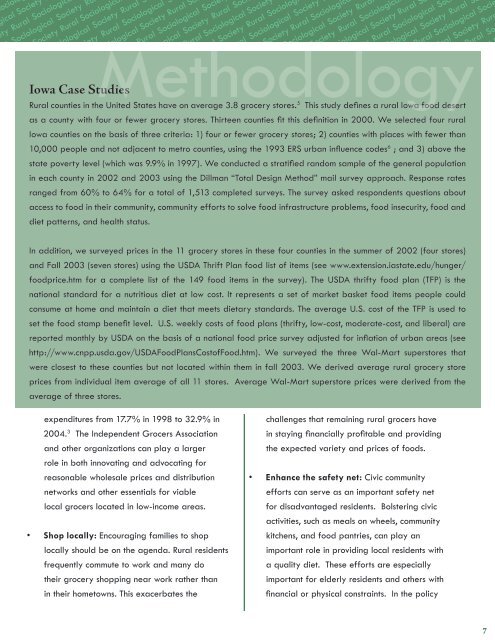Starved for Access: Life in Rural America's Food Deserts
Starved for Access: Life in Rural America's Food Deserts
Starved for Access: Life in Rural America's Food Deserts
Create successful ePaper yourself
Turn your PDF publications into a flip-book with our unique Google optimized e-Paper software.
Methodology<br />
Iowa Case Studies<br />
ociolog<br />
ical ral SociologicalSocietyRura<br />
iologicalSociety<strong>Rural</strong>Sociological<br />
Society<strong>Rural</strong>SociologicalSociety<strong>Rural</strong>So<br />
y SociologicalSociety<strong>Rural</strong>SociologicalSo<br />
l ical Society<strong>Rural</strong>SociologicalSociety<strong>Rural</strong>SociologicalSociety<br />
ociety<strong>Rural</strong>SociologicalSociety<strong>Rural</strong>SociologicalSociety<strong>Rural</strong>Socio<br />
<strong>Rural</strong>SociologicalSociety<strong>Rural</strong>SociologicalSociety<strong>Rural</strong>SociologicalSociety<br />
ogicalSociety<strong>Rural</strong>SociologicalSociety<strong>Rural</strong>SociologicalSociety<strong>Rural</strong>Sociologic<br />
<strong>Rural</strong> counties <strong>in</strong> the United States have on average 3.8 grocery stores. 5 This study def<strong>in</strong>es a rural Iowa food desert<br />
as a county with four or fewer grocery stores. Thirteen counties fit this def<strong>in</strong>ition <strong>in</strong> 2000. We selected four rural<br />
Iowa counties on the basis of three criteria: 1) four or fewer grocery stores; 2) counties with places with fewer than<br />
10,000 people and not adjacent to metro counties, us<strong>in</strong>g the 1993 ERS urban <strong>in</strong>fluence codes 6 ; and 3) above the<br />
state poverty level (which was 9.9% <strong>in</strong> 1997). We conducted a stratified random sample of the general population<br />
<strong>in</strong> each county <strong>in</strong> 2002 and 2003 us<strong>in</strong>g the Dillman “Total Design Method” mail survey approach. Response rates<br />
ranged from 60% to 64% <strong>for</strong> a total of 1,513 completed surveys. The survey asked respondents questions about<br />
access to food <strong>in</strong> their community, community ef<strong>for</strong>ts to solve food <strong>in</strong>frastructure problems, food <strong>in</strong>security, food and<br />
diet patterns, and health status.<br />
ral SociologicalSociety<strong>Rural</strong>SociologicalSociety<strong>Rural</strong>SociologicalSociety<strong>Rural</strong>Soc<br />
Society<strong>Rural</strong>SociologicalSociety<strong>Rural</strong>SociologicalSociety<strong>Rural</strong>SociologicalSocie<br />
SociologicalSociety<strong>Rural</strong>SociologicalSociety<strong>Rural</strong>SociologicalSociety<strong>Rural</strong>So<br />
ociety<strong>Rural</strong>SociologicalSociety<strong>Rural</strong>SociologicalSociety<strong>Rural</strong>SociologicalSocie<br />
ologicalSociety<strong>Rural</strong>SociologicalSociety<strong>Rural</strong>SociologicalSocietyRura<br />
logicalSociety<strong>Rural</strong>SociologicalSociety<strong>Rural</strong>Sociological<br />
ociologica<br />
o<br />
y <strong>Rural</strong> SociologicalSociety<strong>Rural</strong>SociologicalSociety<strong>Rural</strong>SociologicalSocietyR<br />
ogicalSociety<strong>Rural</strong>SociologicalSociety<strong>Rural</strong>SociologicalSociety<strong>Rural</strong>Sociological<br />
SociologicalSociety<strong>Rural</strong>SociologicalSociety<strong>Rural</strong>SociologicalSociety<strong>Rural</strong><br />
cal Society<strong>Rural</strong>SociologicalSociety<strong>Rural</strong>SociologicalSociety<strong>Rural</strong>Sociological<br />
In addition, we surveyed prices <strong>in</strong> the 11 grocery stores <strong>in</strong> these four counties <strong>in</strong> the summer of 2002 (four stores)<br />
and Fall 2003 (seven stores) us<strong>in</strong>g the USDA Thrift Plan food list of items (see www.extension.iastate.edu/hunger/<br />
foodprice.htm <strong>for</strong> a complete list of the 149 food items <strong>in</strong> the survey). The USDA thrifty food plan (TFP) is the<br />
national standard <strong>for</strong> a nutritious diet at low cost. It represents a set of market basket food items people could<br />
consume at home and ma<strong>in</strong>ta<strong>in</strong> a diet that meets dietary standards. The average U.S. cost of the TFP is used to<br />
set the food stamp benefit level. U.S. weekly costs of food plans (thrifty, low-cost, moderate-cost, and liberal) are<br />
reported monthly by USDA on the basis of a national food price survey adjusted <strong>for</strong> <strong>in</strong>flation of urban areas (see<br />
http://www.cnpp.usda.gov/USDA<strong>Food</strong>PlansCostof<strong>Food</strong>.htm). We surveyed the three Wal-Mart superstores that<br />
were closest to these counties but not located with<strong>in</strong> them <strong>in</strong> fall 2003. We derived average rural grocery store<br />
prices from <strong>in</strong>dividual item average of all 11 stores. Average Wal-Mart superstore prices were derived from the<br />
average of three stores.<br />
expenditures from 17.7% <strong>in</strong> 1998 to 32.9% <strong>in</strong><br />
2004. 3 The Independent Grocers Association<br />
and other organizations can play a larger<br />
role <strong>in</strong> both <strong>in</strong>novat<strong>in</strong>g and advocat<strong>in</strong>g <strong>for</strong><br />
reasonable wholesale prices and distribution<br />
networks and other essentials <strong>for</strong> viable<br />
local grocers located <strong>in</strong> low-<strong>in</strong>come areas.<br />
• Shop locally: Encourag<strong>in</strong>g families to shop<br />
locally should be on the agenda. <strong>Rural</strong> residents<br />
frequently commute to work and many do<br />
their grocery shopp<strong>in</strong>g near work rather than<br />
<strong>in</strong> their hometowns. This exacerbates the<br />
challenges that rema<strong>in</strong><strong>in</strong>g rural grocers have<br />
<strong>in</strong> stay<strong>in</strong>g f<strong>in</strong>ancially profitable and provid<strong>in</strong>g<br />
the expected variety and prices of foods.<br />
• Enhance the safety net: Civic community<br />
ef<strong>for</strong>ts can serve as an important safety net<br />
<strong>for</strong> disadvantaged residents. Bolster<strong>in</strong>g civic<br />
activities, such as meals on wheels, community<br />
kitchens, and food pantries, can play an<br />
important role <strong>in</strong> provid<strong>in</strong>g local residents with<br />
a quality diet. These ef<strong>for</strong>ts are especially<br />
important <strong>for</strong> elderly residents and others with<br />
f<strong>in</strong>ancial or physical constra<strong>in</strong>ts. In the policy<br />
7
















